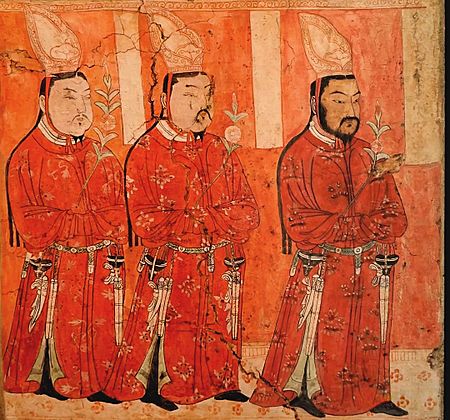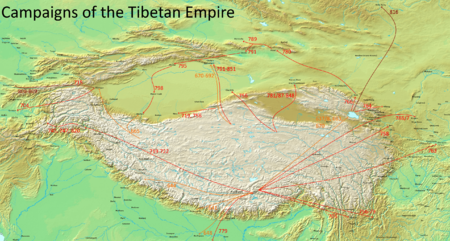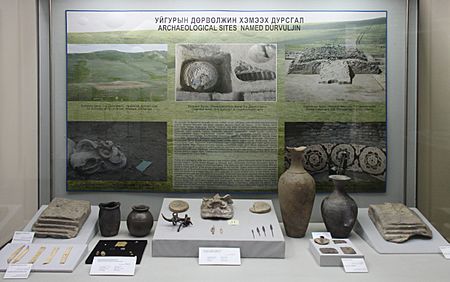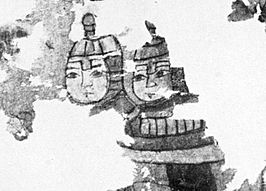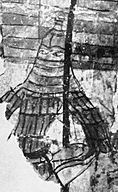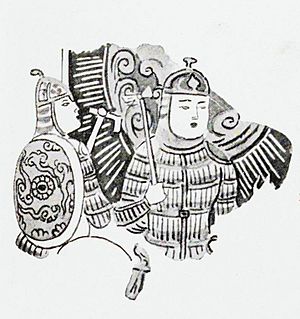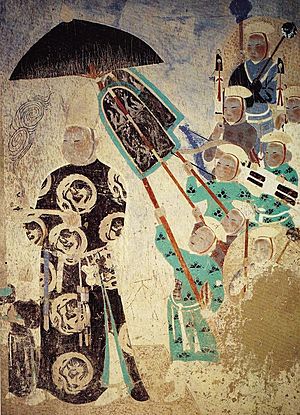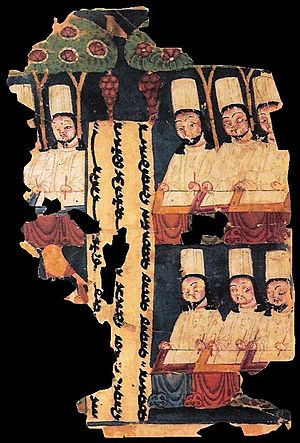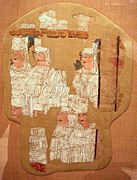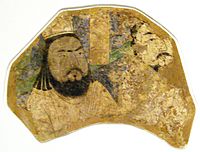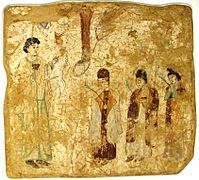Uyghur Khaganate facts for kids
Quick facts for kids
Uyghur Khaganate
𐱃𐰆𐰴𐰕:𐰆𐰍𐰕:𐰉𐰆𐰑𐰣
Toquz Oɣuz budun |
|||||||||||||||
|---|---|---|---|---|---|---|---|---|---|---|---|---|---|---|---|
| 744–840 | |||||||||||||||
| Status | Khaganate (Nomadic empire) | ||||||||||||||
| Capital |
|
||||||||||||||
| Common languages |
|
||||||||||||||
| Religion |
|
||||||||||||||
| Government | Monarchy | ||||||||||||||
| Khagan | |||||||||||||||
|
• 744–747
|
Qutlugh Bilge Köl (first) | ||||||||||||||
|
• 841–847
|
Enian Qaghan (last) | ||||||||||||||
| History | |||||||||||||||
|
• Established
|
744 | ||||||||||||||
|
• Disestablished
|
840 | ||||||||||||||
| Area | |||||||||||||||
| 800 | 3,100,000 km2 (1,200,000 sq mi) | ||||||||||||||
|
|||||||||||||||
The Uyghur Khaganate (also known as the Uyghur Empire) was a powerful Turkic empire. It existed for about 100 years, from the mid-8th to the mid-9th centuries. The Uyghurs called their country the "Toquz-Oghuz country," meaning "Nine Clan People." This empire was a group of tribes led by the Orkhon Uyghur nobility. The Chinese called them the "Nine Clans" (Jiu Xing).
Contents
History of the Uyghur Empire
How the Uyghur Empire Began
In the mid-5th century, the Uyghurs were a tribe within a larger Turkic empire. By 657, the Tang dynasty of China defeated the Western Turkic Khaganate. After this, the Uyghurs allied with the Tang. They had already shown interest in working with the Tang by fighting against the Tibetan Empire and other Turkic groups in 627.
In 742, the Uyghurs, Karluks, and Basmyls rebelled against the Second Turkic Khaganate. By 744, the Basmyls captured the Turkic capital, Ötüken, and killed their ruler. Soon after, the Uyghurs and Karluks formed an alliance. They defeated the Basmyls, whose leader was killed. The Basmyls then disappeared as a distinct group.
However, the Uyghurs and Karluks soon became enemies. This led the Karluks to move west into Zhetysu. There, they fought and conquered the Türgesh people in 766.
The first Uyghur ruler was named Qullığ Boyla. He took the title Kutlug Bilge Kol Khagan, meaning "Glorious, wise, mighty ruler." He claimed to be the supreme leader of all the tribes. He built his capital city at Ordu-Baliq. Chinese records say the Uyghur Empire stretched from the Shiwei people in the east to the Altai Mountains in the west. It also controlled the Gobi Desert in the south. This covered a vast area, similar to the ancient Xiongnu lands. In 745, the Uyghurs defeated the last ruler of the Göktürks and sent his head to the Tang dynasty.
The Golden Age of the Uyghurs

The Uyghurs were known for being careful with resources and working together. This made their empire very strong. In 747, Qutlugh Bilge Köl Kaghan passed away. His youngest son, Bayanchur Khan, became the new ruler, known as Khagan El etmish bilge. This title meant "State settled, wise."
Bayanchur Khan built several trading posts with the Tang dynasty. He used the money from these trades to build the capital city, Ordu-Baliq. He also built another city called Bai Baliq further along the Selenga River. The new ruler then launched campaigns to unite all the steppe peoples under his control. During this time, the empire grew quickly. It brought many groups, including the Kyrgyz and Karluks, under Uyghur rule.
In 751, the Tang Empire faced a major defeat against the Arabs in the Battle of Talas. After this, the Tang withdrew from Central Asia. This allowed the Uyghurs to become the most powerful force in the region.
In 755, a rebellion led by An Lushan broke out against the Tang dynasty. Emperor Suzong of Tang asked Bayanchur Khan for help in 756. The Uyghur ruler agreed, sending his eldest son with about 4,000 Uyghur horsemen. These forces helped the Tang armies retake the cities of Chang'an and Luoyang in 757. After the battle for Luoyang, the Uyghurs took many valuable items from the city. The Tang dynasty rewarded them with large amounts of silk and special titles. They also set up a horse trade where 40 rolls of silk were exchanged for each horse. Uyghurs were also given special "guest" status when visiting Tang China. To strengthen their alliance, the Tang and Uyghurs arranged marriages between their royal families. Bayanchur Khan married Princess Ninguo, and a Uyghur princess married a Tang prince.
In 758, the Uyghurs focused on the northern Yenisei Kyrgyz. Bayanchur Khan destroyed several Kyrgyz trading posts. He then defeated a Kyrgyz army and captured their leader.
In 759, Bayanchur Khan passed away. His son, Tengri Bögü, became the new ruler. He took the title Qutlugh Tarkhan sengün.
In 762, Tengri Bögü initially planned to invade the Tang dynasty. However, after talks, he changed his mind and helped the Tang defeat the rebels in Luoyang. After this victory, the Uyghurs again took many items from the city. When people sought safety in Buddhist temples, the Uyghurs burned them, causing many deaths. To make the Uyghurs leave, the Tang had to pay them 100,000 pieces of silk. During this campaign, the ruler met Manichaean priests. He converted to Manichaeism, which then became the official religion of the Uyghur Khaganate.
Challenges and Decline
In 779, Tengri Bögü planned another invasion of the Tang dynasty. His advisors, who were from Sogdia, encouraged this. But Tengri Bögü's uncle, Tun Baga Tarkhan, disagreed. He removed Tengri Bögü from power and also removed many of the ruler's family and advisors. Tun Bagha Tarkhan became the new ruler, with the title Alp Qutlugh Bilge, meaning "Victorious, glorious, wise." He introduced new laws to keep the empire united. During his rule, Manichaeism was temporarily suppressed, but later rulers brought it back as the official religion.
In 780, some Uyghurs and Sogdians were killed while leaving Chang'an with gifts for the Tang. Tun demanded a large payment in gold and silk, which the Tang agreed to. In 789, Tun Bagha Tarkhan died, and his son, Külüg Qaghan, became ruler. The Karluks took this chance to expand into Uyghur territory. In 790, the Uyghurs and Tang forces were defeated by the Tibetan Empire at Tingzhou. Külüg Qaghan died, and his son, A-ch'o, became the new ruler, Qutluq Bilge Qaghan.
In 791, the Tibetans attacked Lingzhou but were driven away by the Uyghurs. The Uyghurs also defeated the Tibetans and Karluks at Beiting. In 792, the Uyghurs, led by Baoyi Qaghan, defeated the Tibetans and Karluks again, taking control of Gaochang. In 795, Qutluq Bilge Qaghan died, ending the rule of the Yaglakar clan. A general named Qutluq II declared himself the new ruler, starting a new dynasty, the Ädiz clan.
In 803, the Uyghurs captured Qocho. In 808, Qutluq II died, and his son, Baoyi, became ruler. That same year, the Uyghurs took Liang Province from the Tibetans. In 816, a Tibetan attack came very close to the Uyghur capital, Ordu-Baliq. In 821, Baoyi Qaghan died, and his son, Chongde, became ruler. Chongde was seen as the last great ruler of the Uyghur Khaganate. He improved trade with the Sogdia region and pushed back invading Tibetans in 821. After defeating the Tibetan and Karluk forces, the Uyghurs entered the Principality of Ushrusana and took valuable goods from the area.
In 822, the Uyghurs offered to help the Tang dynasty with rebels. The Tang refused but had to pay them 70,000 pieces of silk to return home. In 823, the Tibetan Empire fought against the Uyghurs. In 824, Chongde died and was followed by his brother, Qasar. In 832, Qasar was removed from power. Chongde's son, Hu, became ruler.
The Fall of the Uyghur Empire
In 839, the ruler Hu lost power and died. A minister named Kürebir took the throne with the help of 20,000 Shatuo horsemen. That same year, there was a severe famine and a widespread illness. A very cold winter also killed many animals, which was a disaster for the Uyghur economy.
In 840, one of the Uyghur ministers, Kulug Bagha, who was Kürebir's rival, fled to the Yenisei Kyrgyz. He invited them to invade from the north. With a large force of about 80,000 horsemen, the Kyrgyz attacked the Uyghur capital at Ordu-Baliq. They destroyed the city completely. The Kyrgyz captured the Uyghur ruler, Kürebir, and executed him. They continued to destroy other cities across the Uyghur empire.
The Uyghurs fled in two main groups. One group of 30,000, led by Ormïzt, sought safety in Tang territory. However, Emperor Wuzong of Tang ordered the borders closed. The other group, numbering 100,000, was led by Öge, the new ruler of the defeated Uyghur Khaganate. Öge also fled to Tang territory. He asked for a Tang city to live in, protection for Manichaeans, and food. Emperor Wuzong found these demands unacceptable and refused. He granted Ormïzt asylum in exchange for using his troops against Öge. Two years later, Emperor Wuzong also ordered the banning of Christianity, Zoroastrianism, and especially Buddhism.
The Yenisei Kyrgyz and the Tang dynasty formed an alliance. They fought a successful war against the Uyghur Khaganate between 840 and 848.
In 841, Öge led the Uyghurs in an invasion of what is now Shaanxi.
In 843, a Tang army led by Shi Xiong attacked Öge's Uyghurs. They defeated 10,000 Uyghurs on February 13, 843, at a place called "Kill the Barbarians" Mountain. Öge was injured. After Öge's defeat, Emperor Wuzong ordered Ormïzt's troops to be split up. Ormïzt refused, and his troops were defeated by general Liu Mian. With the two main Uyghur groups defeated, Wuzong took the opportunity to suppress the Manichaeans. He ordered Manichaean temples in several cities to be destroyed. Their properties were taken, and their religious leaders were executed.
In 846, Öge, the second-to-last Uyghur ruler, was killed. He had spent six years fighting the Kyrgyz, his rival Ormïzt's supporters, and Tang dynasty troops. His brother, Enian Qaghan, was decisively defeated by Tang forces in 847.
What Happened After: Successor States
The Yenisei Kyrgyz took over after the Uyghur Khaganate fell. However, they were not very interested in managing the large empire they had destroyed. They controlled the land from Lake Baikal in the east to the Irtysh River in the west. They left Kulug Bagha, the Uyghur who had helped them, in charge of the Orkhon Valley.
After the fall of the Uyghur Khaganate, many Uyghurs moved south. They established two new kingdoms: the Ganzhou Uyghur Kingdom in modern Gansu and the Kingdom of Qocho near modern Turpan. The Uyghurs in Qocho converted to Buddhism. The Ganzhou Uyghurs were later conquered by the Tangut people in the 1030s.
In 1134, Qocho became a vassal state of the new Qara Khitai empire. In 1209, the ruler of Qocho, Barchuk Art Tegin, pledged loyalty to Genghis Khan. The Uyghurs then became important officials in the later Mongol Empire. The Mongols even adopted the Old Uyghur alphabet as their official writing system. According to Chinese records, a third group of Uyghurs sought safety among the Karluks.
The Karluks, along with other tribes like the Chigils and Yagmas, later founded the Kara-Khanid Khanate (940–1212). Some historians believe the Karakhanids were connected to the Uyghurs through the Yaghmas tribe. Sultan Satuq Bughra Khan, thought to be a Yagma from Artux, converted to Islam in 932. He took control of Kashgar in 940, starting the new Karakhanid dynasty.
Uyghur Connections with the Sogdians
To control trade along the famous Silk Road, the Uyghurs formed a trading partnership with Sogdian merchants. These merchants managed many of the important oasis cities in Central Asia. The Uyghurs' decision to adopt Manichaeism as their official religion was part of this relationship. Choosing Manichaeism over Buddhism might have been a way to show they were independent from the influence of the Tang dynasty.
Not all Uyghurs supported this religious change. An inscription at Ordu-Baliq mentions that Manichaeans tried to turn people away from their older shamanistic beliefs. The Uyghur rulers saw that their power depended on providing economic benefits for their people. So, forming an alliance with the Sogdians by adopting their religion was a key way to achieve this goal.
Both the Sogdians and the Uyghurs gained a lot from this partnership. The Sogdians helped the Uyghurs trade in the Western Regions, exchanging silk from China for other goods. For the Sogdians, this alliance gave their trading communities in China protection from the Uyghurs. Sogdians were the main traders along the Silk Roads, and China was always their biggest market. Rulers of both nomadic groups and settled states understood how important merchants like the Sogdians were. They made alliances to help their own goals in controlling the Silk Roads.
-
An Uyghur Manichaean Elect (a religious leader) shown on a temple banner from Qocho.
Karabalghasun: The Uyghur Capital
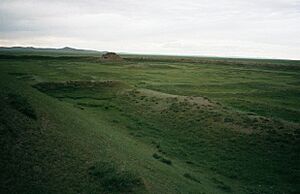
The Uyghurs built an empire with clear influences from Persia, especially in how their government was run. Soon after the empire was founded, they copied settled states by building a permanent capital city. This city was Karabalghasun, also known as Ordu-Baliq. It was built on the same spot where the former Göktürk imperial capital once stood. This location was northwest of the later Mongol capital, Karakorum.
Karabalghasun was a strong, fortified trading hub, typical of cities along the Silk Road. It had multiple walls, lookout towers, stables, and buildings for military and trade goods, as well as for government. Specific areas of the city were set aside for trade and crafts. In the center were palaces and temples, including a monastery. The main palace had strong walls and two main gates, surrounded by moats filled with water and watchtowers.
The Uyghur ruler kept his court there and made all the important decisions for the empire. Earlier nomadic groups like the Xiongnu could only carry a limited amount of Chinese goods. But by building a fixed city, the Uyghurs created a safe place to store trade goods from China. This allowed them to have a stable court, welcome traders, and firmly establish their central role in Silk Road trade. However, having a fixed city also made them vulnerable, which eventually contributed to the Uyghurs' downfall.
List of Uyghur Rulers (Khagans)
The following list shows the rulers of the Uyghur Khaganate.
| Personal Name | Turkic title | Chinese title | Reign |
|---|---|---|---|
| Kutlug Bilge Qaghan Yaoluoge Yibiaobi | Qutlugh Bilge Köl Qaghan | Huairen Khagan (懷仁可汗) | 744–747 |
| Bayanchur Qaghan Yaoluoge Moyanchuo | Tengrida Bolmish El Etmish Bilge Qaghan | Yingwu Weiyuan Pijia Qaghan (英武威遠毗伽闕可汗) | 747–759 |
| Bogu Qaghan Yaoluoge Yidijian | Tengrida Qut Bolmish El Tutmish Alp Külüg Bilge Qaghan | Yingyi Qaghan (英義可汗) | 759–780 |
| Tun Baga Tarkhan Yaoluoge Dunmohe | Alp Qutlugh Bilge Qaghan | Wuyi Chenggong Qaghan (武義成功可汗)
Changshou Tianqin Qaghan (長壽天親可汗) |
780–789 |
| Kulug Bilge Qaghan Yaoluoge Duoluosi | Külüg Bilge Qaghan | Zhongzhen Qaghan (忠貞可汗) | 789–790 |
| Qutluq Bilge Qaghan Yaoluoge Achuo | Qutluq Bilge Qaghan | Fengcheng Qaghan (奉誠可汗) | 790–795 |
| Qutluq II Bilge Qaghan Adie Guduolu, later
Yaoluoge Guduolu |
Ay Tengride Ulugh Bolmish Alp Qutluq Külüg Bilge Qaghan | Huaixin Qaghan (懷信可汗) | 795–808 |
| Baoyi Qaghan | Ay Tengride Qut Bolmish Alp Bilge Qaghan | Baoyi Qaghan (保義可汗) | 808–821 |
| Chongde Qaghan | Kün Tengride Ulugh Bolmish Küçlüg Bilge Qaghan | Chonde Qaghan (崇德可汗) | 821–824 |
| Zhaoli Qaghan | Ay Tengride Qut Bolmish Alp Bilge Qaghan | Zhaoli Qaghan (昭禮可汗) | 824–833 |
| Zhangxin Qaghan Yaoluoge Hu | Ay Tengride Qut Bolmish Alp Külüg Bilge Qaghan | Zhangxin Qaghan (彰信可汗) | 833–839 |
| Qasar Qaghan (Usurper) Jueluowu or
Yaoluoge Hesa |
Qasar Qaghan (㕎馺特勒) | 839–840 | |
| Uge Qaghan Yaoluoge Wuxi | Wujie Qaghan (烏介可汗) | 841–846 | |
| Enian Qaghan Yaoluoge E'nian | Enian Qaghan (遏捻可汗) | 846–848 |
Menglig Qaghan (r. 848–?), (personal name, Mang/Pang Te-qin 厖特勤), sovereign title: Ay Tengride Qut Bolmiş Alp Kutlugh Bilge Qaghan 溫祿登里邏汩沒密施合俱錄毗伽, Chinese title: Huaijian Qaghan 懷建可汗. He moved his political centre to the west.
Buddhist and Manichean Uyghur Artifacts
Below is a set of images of Buddhist and Manichean Uyghurs, found from the Bezeklik caves and Mogao grottoes.
-
An Uyghur Balbal stele from Burana, Kyrgyzstan.
See also
 In Spanish: Kanato uigur para niños
In Spanish: Kanato uigur para niños
- History of Turkic people
- History of the Uyghur people
- An Lushan Rebellion
- Ethnic groups in Chinese history
- Guo Ziyi



